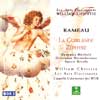Rameau La Guirlande
An enlightened coupling of littleknown ballets with excellent soprano singing and largely responsive ensemble work
View record and artist detailsRecord and Artist Details
Composer or Director: Jean-Philippe Rameau
Label: Erato
Magazine Review Date: 9/2001
Media Format: CD or Download
Media Runtime: 95
Mastering:
DDD
Catalogue Number: 8573 85774-2

Tracks:
| Composition | Artist Credit |
|---|---|
| (La) Guirlande |
Jean-Philippe Rameau, Composer
(Les) Arts Florissants Chorus (Les) Arts Florissants Orchestra Cappella Coloniensis François Bazola, Bass Jean-Philippe Rameau, Composer Paul Agnew, Tenor Sophie Daneman, Soprano William Christie, Conductor |
| Zéphyre |
Jean-Philippe Rameau, Composer
(Les) Arts Florissants Chorus (Les) Arts Florissants Orchestra Cappella Coloniensis Gaëlle Méchaly, Soprano Jean-Philippe Rameau, Composer Rebecca Ockenden, Soprano Sophie Decaudaveine, Soprano William Christie, Conductor |
Author:
Arcadian flora is the overriding image in these two oneact ballets‚ or actes de ballets as they were known‚ where undistinguished libretti and unambitious plots still inspire creativity of a rare order in Rameau. While historians have tended over generations to imply that Rameau’s burning dramatic zeal and inventive spark stop with the large tragédies lyriques (and the odd largescale ballethybrid like Platée)‚ there can be no doubt that this contained singleact genre deserves to be regarded on its own terms. Certainly‚ in his time such pieces were sought after both at court and in the public domain. If Pygmalion is accepted as one of Rameau’s great smallscale achievements‚ then its use of ballet as a significant ingredient in the narrative is adopted in La guirlande from three years later. The first performance was held at the Académie Royale de Musique in 1751 in a triple bill‚ and one can imagine how its instantly revealed charms would have beguiled; the opening sequence of a swain‚ Myrtil‚ returning from having ‘played away’‚ glistens with melodic incident and vocal curvature‚ and is affectionately delivered by Paul Agnew.
While the plot is concerned with the usual pastoral themes of fidelity and bluff‚ using the ubiquitous garland as the emblem‚ the real essence of the experience lies in the intricate delicacy of the score. The Shepherdess‚ Zélide‚ boasts an air (‘Tout languit dans nos bois’) of extraordinary poignancy: Rameau here responds to the human condition through supposedly surface sensibilities but they reveal so much more through their economy of means and discriminating manipulation. The artistry of the music is matched by the fastbecoming doyenne of French Baroque sopranos‚ Sophie Daneman. The music is rich with dance‚ though there is not quite the showstopping musette of La Danse in Les fêtes d’Hébés. There is also a splendid ‘triomphe amour’ figure which‚ again‚ appears to have been forged from the Pygmalion model. Perhaps‚ however‚ this is where comparisons should cease: for all the incidental qualities of La guirlande‚ the quality of the music tails off a little towards the end.
The Cappella Coloniensis des WDR are indeed welldrilled‚ as befits a Christie project‚ but there is something about this band which is not quite as responsive as Les Arts Florissants‚ and which becomes more noticeable in the even richer score of Zéphyre. With typical imagination however‚ Christie presents this shorter gem of a oneacter with singers who bring an alternative perspective to the overall vocal bouquet. Here‚ the plot concerns Zéphyre‚ the West Wind‚ luring the chaste nymph‚ Cloris‚ to amorous indiscretion in scented groves of flower dances. Diana arrives with paramour (with Cupid having fired all his darts) and proclaims the nymph‚ Cloris‚ Goddess of Spring. Chastity no longer applies. Gaëlle Méchaly‚ in the titlerole‚ is a light‚ agile‚ coquettish soprano of considerable wit and musical instinct. She negotiates her allpervasively decorous ariettes (of which this piece contains more good examples than La guirlande) with remarkable deftness; ‘L’amour a des appas toujours victorieux’ is exquisite‚ as is the little minuet which opens ‘les groupes de fleurs’. Cloris submits to her fate with a supporting role‚ here articulated with the agreeably distinctive and warm vocal timbre of Rebecca Ockenden‚ alongside the voracious Zéphyre.
Graham Sadler’s authoritative notes accompany this set‚ providing insights into a side of Rameau’s oeuvre which has too often been regarded as a poor relation to the fulllength operatic creations (egged on by Cuthbert Girdlestone’s description of La guirlande as ‘Dresdenchina Rameau’). On their own terms‚ these ballets explore the unique inner beauty and subtlety of the composer in fleeting nuances – just another side of this remarkable figure. Well worth exploring.
Discover the world's largest classical music catalogue with Presto Music.

Gramophone Digital Club
- Digital Edition
- Digital Archive
- Reviews Database
- Full website access
From £8.75 / month
Subscribe
Gramophone Full Club
- Print Edition
- Digital Edition
- Digital Archive
- Reviews Database
- Full website access
From £11.00 / month
Subscribe
If you are a library, university or other organisation that would be interested in an institutional subscription to Gramophone please click here for further information.




